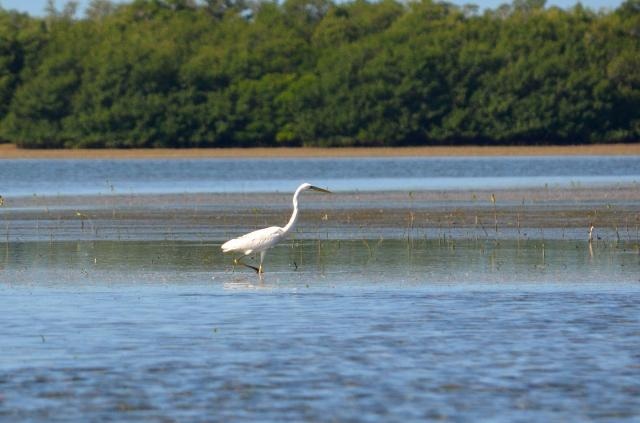May 4 2016
Coastal wading birds shape their lives around the tides, and new research in The Auk: Ornithological Advances shows that different species respond differently to shifting patterns of high and low water according to their size and daily schedules, even following prey cycles tied to the phases of the moon.
 A Great White Heron forages in intertidal habitat. Credit: L. Calle
A Great White Heron forages in intertidal habitat. Credit: L. Calle
Many birds rely on the shallow water of the intertidal zone for foraging, but this habitat appears and disappears as the tide ebbs and flows, with patterns that go through monthly cycles of strong "spring" and weak "neap" tides. Leonardo Calle of Montana State University (formerly Florida Atlantic University) and his colleagues wanted to assess how wading birds respond to these changes, because different species face different constraints--longer-legged birds can forage in deeper water than those with shorter legs, and birds that are only active during the day have different needs than those that will forage day or night.
Changes in the daily schedules of tidal flooding affected smaller, daylight-dependent Little Blue Herons more than Great White Herons, which have longer legs and forage at night when necessary. The abundance of foraging wading birds was also tied to the phases of the moon, but this turned out not to be driven directly by changes in the availability of shallow-water habitat. Instead, the researchers speculate that the birds were responding to movements of their aquatic prey timed to the spring-neap tide cycle, a hypothesis that could be confirmed through a study jointly tracking predator and prey abundance.
"Wading birds are a cog in the wheel that is the intertidal ecosystem, and the intertidal ecosystem is driven by tidal forces--everything depends on tides," says Calle. "The nuances of how water levels rise and fall over time and space are very important to understand in order to assess how birds feed. Ultimately, this will help us determine if birds have enough area or enough time to fulfill their energy demands and which areas require greater attention or protection."
Calle and his colleagues conducted their seasonal surveys of foraging wading birds from 2010 to 2013, working from a boat at low tide in Florida's Great White Heron National Wildlife Refuge. "First the Great White Herons would arrive, followed by the other birds," says Calle. "Sharks and rays would be on the edge of the flats. Once, not ten feet from the bow of my kayak, a green turtle popped its head above the water and drew a breath just as a grazing manatee drifted by."
"The model developed by Calle et al. makes a significant contribution to our understanding of the factors that drive the abundance of herons and egrets in tidal areas," according to John Brzorad of Lenoir-Rhyne University, an expert on egret ecology. "Although it has been long observed that abundance varies with tidal phase, these authors incorporate time of day, moon phase, and season and allow predictions to be made about bird abundance based on modeling hectares available for foraging birds. It will be exciting to apply this model to other tidal areas."
Source: http://www.aoucospubs.org/